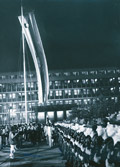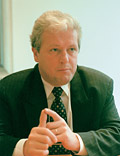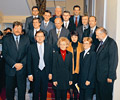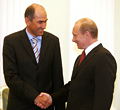Chronology of Events 1991-2006
1991 |
|
|
25 June The Assembly of the Republic of Slovenia adopts the Basic Constitutional Charter on the Independence and Sovereignty of the Republic of Slovenia, the Constitutional Act Implementing the Basic Constitutional Charter, and the Declaration of Independence. |
|
|
26 June Solemn proclamation of Slovenia's independence and sovereignty. Croatia recognises Slovenia. 27 June Yugoslav People's Army invades Slovenia. The Presidency of the Republic of Slovenia makes the decision that Slovenia will defend its independence and sovereignty with all available resources. 7 July Following intervention from the European Community, the Brioni Agreement is adopted, which stipulates that Slovenia and Croatia implement a three-month moratorium on all their independence activities. 24 July An administrative rule on the release of all Slovenian soldiers from the Yugoslav Army is issued. 30 July Lithuania recognises Slovenia. 13 August On behalf of the Slovenian leadership, foreign minister Dimitrij Rupel sends a 'memorandum' containing proposals for resolving the crisis in Slovenia to all CSCE and EC member states. 7 October The moratorium stipulated by the Brioni Agreement expires, and Slovenia starts enforcing its independence legislation. The Assembly approves the tolar as the national currency. Slovenia takes control of her borders. 25 October The last soldier of the Yugoslav Army leaves Slovenian territory. 16 December The foreign ministers of the EC adopt the decision that the EC would recognise the independence of all Yugoslav republics which sought to do so, and meet certain criteria. 19 December Iceland recognises Slovenia. Germany and Sweden do the same, but pass an amendment stipulating that their resolutions would be effective as of 15 January. |
|
|
23 December The Assembly of the Republic of Slovenia passes a new constitution, which becomes the first constitution of independent Slovenia. |
|
1992 |
|
|
13 January The Vatican recognises Slovenia. |
|
|
15 January Slovenia is recognised by France, Belgium, the UK, Denmark, Austria, Switzerland, Malta, Hungary, Norway, Bulgaria, Poland, Australia, Canada and the European Community. |
|
|
17 January Italian president Francesco Cossiga visits Ljubljana and personally presents the documents of recognition. |
|
|
24 March The CSCE Council of Ministers accept Slovenia as a full member. |
|
|
11 April Solemn oath of allegiance of the first generation Slovenian soldiers. |
|
|
14 May At a joint session of the Assembly of the Republic of Slovenia, the MPs elect in a secret ballot a new government headed by the Prime Minister Dr Janez Drnovšek, and this ends the two-year tenure of the government headed by Lojze Peterle. 22 May Slovenia is accepted to the UN as its 176th member. 10 September All chambers of the Assembly of the Republic of Slovenia pass the National Assembly Elections Act, and the National Council Act. 30 September The Bank of Slovenia issues and puts in circulation the newly created tolar banknotes and coins. 6 December The LDS wins the first parliamentary elections, while Milan Kučan wins the presidency elections. |
|
1993 |
|
|
12 January The National Assembly elects Janez Drnovšek Prime Minister, while the cabinet is appointed on 25 January. 15 January Slovenia becomes a member of the International Monetary Fund. 25 February Slovenia becomes a full member of the World Bank. 5 April The Prime Minister Janez Drnovšek and the foreign minister Lojze Peterle sign an Agreement on Cooperation with the representatives of the European Union. 14 May Slovenia officially becomes the 28th full member of the Council of Europe. 29 September The Prime Minister Janez Drnovšek delivers a speech at the 48th UN General Assembly. |
|
1994 |
|
|
30 March At a meeting of the NATO Council, the Prime Minister Janez Drnovšek signs a framework document on Partnership for Peace. |
|
|
8 July The Croatian Prime Minister Nikica Valentić visits Slovenia and signs three interstate agreements with the Slovenian the Prime Minister Janez Drnovšek at Brdo pri Kranju. |
|
|
29 September Ivan Bizjak is elected the first ombudsman. 3 October The National Assembly passes the Establishment of Municipalities and Municipal Boundaries Act. 15 November The National Assembly passes a declaration on the relations between Slovenia, Italy and the EU. 18 November At a meeting of the North-Atlantic Assembly in Washington, Slovenia becomes an associate partner of NATO. |
|
1995 |
|
|
6 March At an EU ministerial in Brussels, Italy withdraws its objections to Slovenia's accession to the EU. 31 March Representatives of unions and employers sign the first social agreement in Ljubljana. 30 July Slovenia becomes the 105th full and founding member of the World Trade Organization. 1 September Slovenia introduces external convertibility of the tolar. 25 November A document on the accession to the CEFTA is signed in Ljubljana. |
|
1996 |
|
|
1 January Slovenia becomes a full member of the Central European Free Trade Agreement (CEFTA). |
|
|
14 March The Prime Minister Janez Drnovšek presents Jean-Claude Paye, Secretary General of the OECD, with Slovenia's membership application. |
|
|
17 May Pope John Paul II visits Slovenia. 10 June Slovenia and the EU sign an association agreement, and Slovenia submits request for full membership in the EU. |
|
|
10 November Parliamentary elections take place. |
|
1997 |
|
|
9 January At its first extraordinary session, the National Assembly re-elects Janez Drnovšek as Prime Minister. The cabinet is appointed on 27 February. |
|
|
5 March Pope John Paul II appoints Franc Rode new Archbishop and Metropolitan Bishop of Slovenia. 17 April Presidents of all parliamentary parties and the representatives of the Hungarian and Italian minorities sign the Declaration on NATO Membership, in which they express 'unwavering support' to Slovenia's integration in NATO. 17 April The government approves a draft act on the ratification of the EU association agreement. 6 and 7 June Presidents of eight member states of the Central European Initiative meet in Piran. 24 June At an extraordinary session, the National Assembly passes a resolution to initiate the procedure for amending the Article 68 of Slovenia's Constitution pertaining to ownership rights to real estate of foreigners, with the required two-third majority of all present MPs. The National Assembly instructs the parliamentary Constitutional Committee to prepare a draft act amending the Constitution. 15 July The National Assembly ratifies the association agreement between Slovenia and the EU. 12 and 13 September Prime ministers of CEFTA member states meet in Portorož. 23 November Milan Kučan is re-elected President of Slovenia. 3 December The foreign minister Boris Frlec signs the Ottawa Mine Ban Treaty, and announces the foundation of the International Trust Fund for Demining and Mine Victims Assistance in Bosnia and Herzegovina. 13 December At the EU Summit in Luxembourg, a decision is taken on a 5+1 EU enlargement formula. Slovenia is one of the candidates. |
|
1998 |
|
|
1 January Slovenia becomes a non-permanent member of the UN Security Council. 26 February The government approves the National Strategy for the Integration of the Republic of Slovenia into NATO. 31 March Slovenia officially enters negotiations for full membership in the EU. 23 May Slovenia presents itself at the EXPOž98 in Lisbon. 1 August Slovenia assumes one-month presidency of the UN Security Council. 8 August The Act Amending the Establishment of Municipalities and Municipal Boundaries Act comes into force, which stipulates additional 45 municipalities to the existing 147. 4 December The Prime Minister Janez Drnovšek meets American President Bill Clinton in the White House. |
|
|
11 November Slovenia becomes the first EU candidate country to sign the Joint Assessment of Medium-Term Economic Policy of Slovenia. |
|
1999 |
|
|
1 February The Association Agreement with the EU comes into effect, and Slovenia officially becomes an associate member of the EU. |
|
|
22 February First meeting of the EU-Slovenia Association Council. |
|
|
7 May Slovenia, France and Romania sign the European Social Charter, one of the most important documents regulating the protection of human rights. |
|
|
21 and 22 June American President Bill Clinton visits Slovenia. 19 September Pope John Paul II visits Slovenia and beatifies the Bishop Anton Martin Slomšek. 1 November As a two-year non-permanent member, Slovenia assumes one-month presidency of the UN Security Council for the second time (the first was in August 1998). |
|
2000 |
|
|
1 January After just over three years of preparations, the reform of the pension and disability insurance system enters implementation phase. |
|
|
6 January UN's Secretary-General Kofi Annan appoints Danilo Türk, incumbent Ambassador of the Republic of Slovenia to the UN, UN Assistant Secretary-General for Political Affairs. |
|
|
3 May In the third round the National Assembly elects Andrej Bajuk Prime Minister. The cabinet is appointed on 7 June. 25 July With the required two-third majority, the National Assembly amends Article 80 of the Constitution, and thus modifies the proportional representation system by stipulating a four per cent threshold. 4 October The President of the Slovenian Academy of Sciences and Arts (SASA), France Bernik, the education minister Lovro Šturm, the Rector of the University of Ljubljana, Jože Mencinger, and the Rector of the University of Maribor, Ludvik Toplak, sign a letter of intent to establish the University of Primorska. 15 October Third parliamentary elections in Slovenia take place. |
|
|
16 November The National Assembly elects Janez Drnovšek Prime Minister. The cabinet is appointed on 30 November. |
|
2001 |
|
|
12 February Slovenia officially assumes six-month co-chairmanship of the Working Table for Democratisation and Human Rights of the Stability Pact for South Eastern Europe. |
|
|
14 February The Italian Senate ratifies an act on the protection of Slovenian minority in Italy. |
|
|
9 May In his address on the occasion of Europe Day, Günther Verheugen emphasises that Slovenia can be proud of its achievements in approaching the EU. |
|
|
14 June The participants of the EU Summit in Göteborg agree that the negotiations with candidate countries should be concluded by the end of 2002, and that the first accessions would take place in 2004. |
|
|
16 June The first meeting between the American and Russian presidents, George W. Bush and Vladimir Putin, takes place at Brdo pri Kranju. 10 October Following an invitation by Slovenia's president, Milan Kučan, Queen Margrethe II of Denmark and her spouse arrive on a three-day visit to Slovenia. 13 November The European Commission issues the Fourth Annual Progress Report which positively assesses Slovenia's progress in the preparations for EU membership. |
|
2002 |
|
|
16 January A public opinion debate on Slovenia's accession to NATO is held in the Parliament. The state leadership expresses strong determination to join the Alliance. |
|
|
15 February At the end of their visit to Slovenia, NATO's group of experts assesses that Slovenia has achieved significant progress in all areas in the preparations for membership. |
|
|
1 April The Statistical Office of the Republic of Slovenia conducts the first census of population, households and housing in independent Slovenia. The data shows that Slovenia has 1,948,250 inhabitants, 688,733 households, and 775,131 dwellings. |
|
|
17 May The Prime Minister Janez Drnovšek meets the American President George W. Bush in Washington. |
|
|
3 July Following an invitation by Slovenia's president, Milan Kučan, King Juan Carlos I of Spain and his spouse, Queen Sophia, pay their first official visit to Slovenia. 25 October At an EU summit, the EU leaders nominate ten candidate countries to join the EU on 1 May 2004. One of them is Slovenia. 21 November At the NATO Summit Meeting in Prague Slovenia is invited to join the Alliance. |
|
|
1 December In the second round of presidential elections, Janez Drnovšek is elected President of Slovenia ahead of Barbara Brezigar. 11 December The National Assembly elects Anton Rop Prime Minister. The cabinet is appointed on 19 December. 13 December Slovenia concludes accession negotiations with the EU. The country is to join the EU on 1 May 2004. |
|
2003 |
|
|
23 March Referenda on Slovenia's accession to the EU and NATO take place. 89.64 per cent of voters opt for joining the EU. 66.08 per cent opt for joining NATO. Electorate turnout is 60.4 per cent. 9 April The European Parliament approves accession of Slovenia and the other nine candidate countries as of 1 May 2004. 16 April The President Janez Drnovšek, the Prime Minister Anton Rop, and the Minister of Foreign Affairs, Dimitrij Rupel, sign the Accession Treaty in Athens. 9 May On the occasion of Europe Day, Pat Cox, President of the European Parliament, Erwan Fouere, Head of the European Commission Representation to Slovenia, and George Nikolaidis, Ambassador of the Hellenic Republic (presiding country of the EU) to Slovenia, present letters of address to Slovenia, a future member of the EU. The European Parliament opens its information office in Ljubljana. 25 June Slovenia celebrates twelve years of independence. A number of celebrations are held across the country. The main celebration in the Trg republike Square in Ljubljana focuses on the young. 5 November The European Commission releases the final report on Slovenia's preparedness to enter the EU. |
|
|
7 November Government representatives of the Central European Free Trade Agreement signatory countries meet at a CEFTA summit in Brdo pri Kranju. 13 November The government adopts a Programme of ERM II Entry and Adoption of the Euro. |
|
2004 |
|
|
28 January The National Assembly ratifies the Accession Treaty and an agreement between Slovenia and the Vatican regarding legal matters. |
|
|
30 January Quadrilaterale - meeting of Prime Ministers of Croatia (Ivo Sanader), Hungary (Péter Medgyessy), Italy (Silvio Berlusconi) and Slovenia (Anton Rop) at Brdo pri Kranju. 24 February With sixty-eight votes in favour and three against, the National Assembly ratifies the North Atlantic Treaty, which established NATO in 1949. 2 March The foreign minister Dimitrij Rupel receives an invitation from Secretary General of NATO, Jaap de Hoop Scheffer, to accede to the North Atlantic Treaty by depositing its protocol of accession. The European Parliament ratifies the final report on the preparedness of Slovenia and other candidate countries to enter the EU on 1 May 2004. 29 March Slovenia joins NATO. |
|
|
30 April On the occasion of Slovenia's accession to the EU the main ceremony is held in Nova Gorica - key-note speakers are Prime Minister Anton Rop, and President of the European Commission, Romano Prodi. Ceremonies marking the occasion of Slovenia's accession are held across the country. 1 May Slovenia becomes an EU member, ceremonies marking the occasion of Slovenia's accession are held across the country. 13 May The government adopts the Convergence Programme, which provides the basis for Slovenia's entry into ERM II and the Eurozone. |
|
|
13 June The first elections to the European Parliament are held in Slovenia. 15 June King Carl XVI Gustaf of Sweden and Queen Silvia arrive on a three-day visit to Slovenia. 28 June Slovenia enters the Exchange Rate Mechanism (ERM II) in preparation for joining the Eurozone. At the Oath of Office ceremony at the Court of Justice of the European Communities, European Commissioners from then new member states are sworn in. One of them is Slovene, Janez Potočnik. |
|
|
3 October Parliamentary elections are held in Slovenia. 29 October In Rome, the heads of 25 EU countries sign the Treaty establishing a Constitution for Europe. Member states are given two years in which to ratify it. 9 November The National Assembly elects the president of the largest parliamentary party (Slovenian Democratic Party - SDS), Janez Janša, Prime Minister. New coalition parties: SDS, New Slovenia (NSi), Slovene People's Party (SLS), and Democratic Party of Slovenian Pensioners (DeSUS) sign a coalition agreement. The government is appointed on 3 December. 22 November A new European Commission headed by the former Portuguese Prime Minister, José Manuel Barroso assumes a five-year office. Member of the Barroso Commission, Janez Potočnik, becomes Commissioner for Science and Research. 25 November Slovenia, as the presiding country, hosts a two-day Central European Initiative Summit attended by the Prime Ministers of seventeen member states in Portorož. |
|
2005 |
|
|
6 January At a regular session, the government adopts a bill for the ratification of the European constitutional treaty, and establishes a core working group responsible for the preparations for Slovenia's presidency of the EU in the first half of 2008. |
|
|
13 January At the permanent council meeting of the OSCE, the Minister of Foreign Affairs, Dimitrij Rupel, OSCE chairman-in-office outlines OSCE's priorities in 2005 to permanent representatives of fifty-five participating states. |
|
|
1 February At an extraordinary session, the National Assembly ratifies the Treaty establishing a Constitution for Europe. 3 February The government approves a plan to introduce the euro in Slovenia. 9 May The state ceremony to mark the 60th anniversary of the end of World War II is held in Ljubljana. |
|
|
22 May On the occasion of the 15th anniversary of the first democratically elected Slovenian government its members meet at Brdo pri Kranju. 10 June Croatian and Slovenian governments hold a meeting at Brijuni to sign several agreements on economic cooperation and express support to further enlargement of the EU. A Slovenian-Croatian historical commission meets for its maiden session in Pula. 11 June A national ceremony commemorating the unrecognised victims of post-war killings takes place at the Teharje Memorial Park. Key-note speaker is President of the Republic of Slovenia, Janez Drnovšek. 23 June At a regular session, the government approves Slovenia's Development Strategy and adopts a bill on balanced regional development, which stipulates that Slovenia be divided into two cohesive regions. 14 July At a regular session, the government approves a bill on dual display of prices in tolars and euros, and appoints a working group, headed by Jože P. Damjan, to prepare a framework of structural reforms. 28 July The government adopts a programme in preparation for Slovenia's EU presidency in the first half of 2008. 6 October The government discusses the guidelines of economic and social reforms, submitted by government reform committee, and briefs the presidents of parliamentary parties, heads of parliamentary groups, representatives of the Italian and Hungarian minorities, and the President of the National Assembly. 7 October Finance minister Andrej Bajuk and the Governor of the Bank of Slovenia, Mitja Gaspari, present the new Slovenian euro coins. |
|
|
3 November Prime Minister Janez Janša presents the framework of economic and social reforms to improve welfare in Slovenia. 5 December OSCE ministerial meeting takes place in Ljubljana. |
|
2006 |
|
|
2 March Following an invitation by the Slovenian Prime Minister Janez Janša, the President of the European Commission, José Manuel Barroso visits Slovenia, accompanied by Margot Wallström, Vice President of the Commission, and Commissioner Janez Potočnik. 17 March Prime Minister Janez Janša attends international conference on EMU entry and the adoption of the euro. 28 March A delegation of the International Monetary Fund (IMF) concludes their regular annual fourteen-day consultation in Slovenia. The Head of the Mission Juan-Jose Fernandez-Ansola, together with finance minister Andrej Bajuk and member of the Governing Board of the Bank of Slovenia, Božo Jašovič, presents an annual economic report on Slovenia's economic situation. According to the IMF, Slovenia is one of the most developed new EU member states, while the adoption of the euro is a noteworthy achievement. |
|
|
18 April Presidents of six parliamentary parties and the representatives of the Hungarian and Italian minorities sign the Partnership for Development Agreement, thus committing themselves to fruitful collaboration in seeking the best responses to future challenges, and to reaching consensus in adopting and promoting reforms. |
|
|
29 May Government representatives, headed by Prime Minister Janez Janša and a strong business delegation pay the first official visit to Russia, where the PM meets the Russian President Vladimir Putin. |
|
|
31 May Following an invitation by Slovenian President Janez Drnovšek, Sovereign Prince Albert II of Monaco visits Slovenia. |
|






























